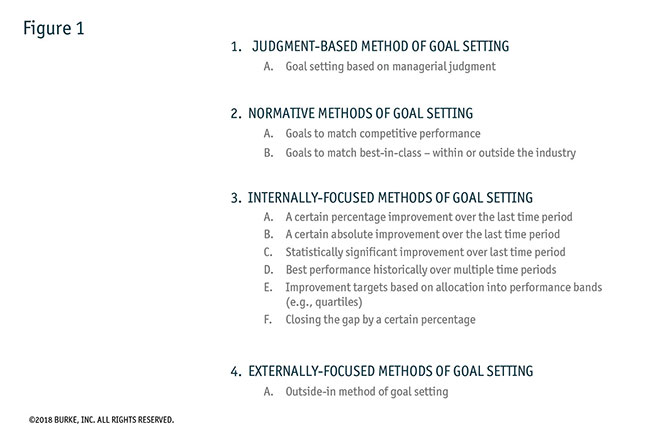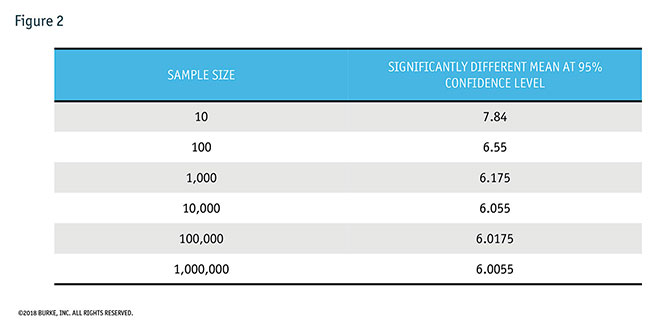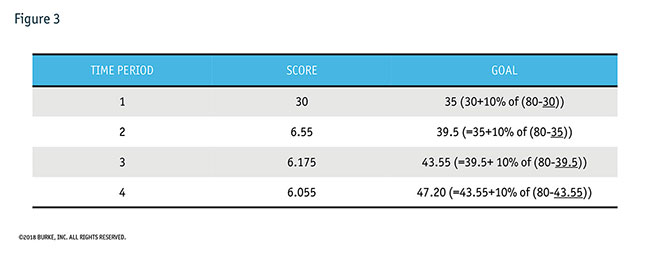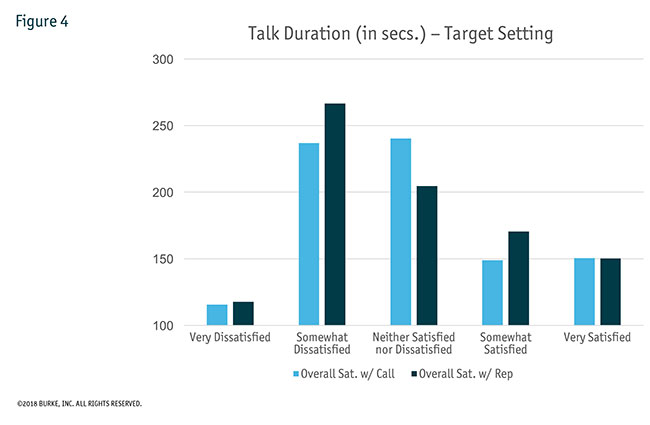Identify the right path to success
Editor's note: Kunal Gupta is senior vice president, senior consultant, decision sciences at Cincinnati research firm Burke, Inc. Jeremy Cochran is manager and senior consultant, decision sciences at Burke, Inc.
 Recently, a client reached out to us for guidance on their goal of improving the customer perception of support center interactions. To accomplish this goal, management set very aggressive targets for “first call” and “on-time resolution” for the coming year. While management felt the targets were very achievable, the frontline employees were worried because the goals felt too aggressive and unachievable. The question we had to answer was: Who, if anyone, was right?
Recently, a client reached out to us for guidance on their goal of improving the customer perception of support center interactions. To accomplish this goal, management set very aggressive targets for “first call” and “on-time resolution” for the coming year. While management felt the targets were very achievable, the frontline employees were worried because the goals felt too aggressive and unachievable. The question we had to answer was: Who, if anyone, was right?
Most companies set goals related to financials or marketing strategy but one of the most important goals a company can set relates to customer experience outcomes. Companies that focus on improving customers’ experiences tend to see improvement in overall customer engagement, which leads to higher retention, greater share of wallet and ultimately, higher profitability.
Improving the customer experience should be fairly easy and straightforward. In its simplest form, all it takes is setting a goal and then working to achieve or meet that goal. So sure, in theory, it is easy. But in reality, things can quickly get complicated.
Here are a few of the questions you need to ask when setting a goal: How do you determine the goal? How do you demonstrate progress towards the goal? What if one team meets a goal and others don’t? Are your goals similar to those of your competitors? How do you know that the goal is meaningful to the overall organization?
Identifying the right method to set and track progress towards a goal helps organizations understand their processes better and make necessary changes to improve. In this article, we’ll talk about the importance of setting goals, discuss what to consider when setting a goal and describe a variety of methods organizations can use to set goals and track progress.
Setting goals
An easy and well-known framework for setting goals is the SMART method.1 SMART goals should be specific, measurable, achievable, relevant and time-framed. This framework is simple, comprehensive, and – when properly deployed – can be very useful.
For the purpose of our discussion, we will share two more goal-setting criteria that are especially helpful in customer experience and engagement research: equitable and empirical.
First, goals should be equitable – meaning they should be fair. Goals that are not equitable could actually end up rewarding weak performers while punishing superior achievers, which we will touch on later.
Second, goals should be empirical. While so many decision makers claim to be data-driven, we often see goals set arbitrarily based on judgment and/or collective experience. Instead, when goals are empirically derived, they can lead to increased confidence and transparency in the goal-setting process along with greater commitment from employees.
Let us discuss some of the commonly used methods of goal setting. The intent of this section is not to be exhaustive, though we do cover a wide range of commonly used methods (Figure 1). These methods range from being more internally focused to following an outside-in approach and being empirical. Each of these approaches has benefits and drawbacks; we are not recommending any one method as the go-to way of setting goals. Instead, we want to highlight a few goal-setting approaches we commonly see applied, highlighting the strengths and weaknesses of each.

Method 1: Judgment-based goal setting (going with your gut)
At one end of the spectrum, businesses could set their goals for customer experience outcomes based on their judgment. Rather than relying on a specific primary or secondary data source, judgment-based goals rely mostly on the tacit and collective agreement of decision makers and/or other organizational stakeholders.
This is one of the most common methods of goal setting in customer experience, with examples ranging from decreasing call-handling time to a focus on delighting customers. It’s not just shooting from the hip; judgment-based goal-setting is usually informed by a variety of sources such as historical performance of the firm, competitive landscape, overarching organizational goals and market trends. For instance, an executive might read an industry report and immediately know that the firm needs to reduce average call-handling time to decrease overall costs and thus to stay competitive in the industry.
The big limitation of this method, however, is that goals are heavily influenced by the tacit knowledge and biases of individual decision makers. Therefore, these goals may not hit any of the SMART metrics.
Here is a firsthand example of a judgment-based goal-setting process gone wrong:
A leading technology provider decided to invest in what it referred to as “customer centricity.” Top stakeholders felt that improvements in customer feedback scores for each customer touchpoint (e.g., online experience, support experience and out-of-the box experience) would boost customer engagement and, ultimately, the health of the brand. However, in their excitement to contribute to the strategic priority, aggressive goals were set without enacting any new programs or initiatives to support employees in their effort to improve customer centricity. Thus these goals were never realized due to lack of employee training and support on this initiative, which led to disappointment and frustration among the employees associated with delivering the “improved” customer experience.
Method 2: Normative-based goal setting (keeping up with the Joneses)
The core idea that supports normative methods of goal setting is to view your firm’s performance in the context of the competition. In other words, a firm sets goals for itself by identifying gaps in its performance compared to competing firms.
The key factor here is the definition and scope of competition. In some cases, such competition is obvious – companies with similar offerings that serve similar customers (e.g., UPS and FedEx, Marriott and Hilton, etc.). In other cases, the definition of competition might expand to competing for the same customer dollars (e.g., cars vs. public transit – different industries but similar functions).
And there are two main targets firms could use to base their competitive goals: competitive performance and best-in-class.
When setting goals based on competitive performance, an organization compares its performance to its competition. For example, the American Customer Satisfaction Index provides normative data on the levels of customer satisfaction for the larger companies within most industries. Here is an example of these scores from the airline industry: https://bit.ly/2NkYRDR.
The limitation of such research could be twofold. First, some of these normative options, given their idiosyncratic methods, might not converge and, in some cases, could even contradict the firm’s own information. Secondly, some of them, by design, may provide a scorecard but not adequate diagnostic information.
Setting goals based on best-in-class providers or companies also relies on normative comparison but the goals are set based on the best performers within – or even outside – the industry. For instance, an airline might view anyone in the travel and hospitality industry, including hotels, restaurants and theme parks, as their normative.
Method 3: Internally focused goal setting (look within)
The core idea of these methods of goal setting is for firms to look at their own historic performance to set future goals. This can be done in a variety of ways:
Improve by a certain percentage: Goals are based on improving from historical performance by a fixed percentage. For example, if the customer experience score for last year was 60 and management decides to set a 10 percent improvement, then the new goal becomes 66 (= 60 + 6). It’s simple and has an air of fairness to it. However, looking at the math, it ends up being unfair by rewarding underachievers; the lower your initial performance, the less absolute improvement you have to make. Higher performers can feel punished while the customer’s experience doesn’t improve.
Improve by an absolute amount: Goals are based on improving by a set number rather than a percentage (e.g., NPS needs to improve by five points across each business line). It’s simple but yet again, underachievers are still rewarded; it’s easier to move when you start at a lower base than a higher one.
Improve by a statistically significant amount: Goals are based on improving by a difference that is significant at a chosen level of confidence (e.g., 95 percent). Statistical significance, however, is heavily influenced by sample size; firms with a large customer base can find even miniscule changes in customer experience scores to be statistically significant. Our table (Figure 2) shows how much a score of 6 needs to increase to be statistically significant at various base sizes, assuming the standard deviation is constant. As you can see, a large base can make it easy to achieve a “significant” result (and vice versa for small base sizes). It’s important to understand that just because a change is significant that does not mean it is substantive; that is, it may not reflect a meaningful change in customers’ actual levels of engagement.
 Improve to the best performance over multiple time periods: Goals are based on the best performance achieved over a certain time period in the past. The logic is simple – if we did it before, why can’t we do it again? An example we’ve worked with was a home services organization whose recent customer experience scores were around 70 percent but had been in the 90 percent range two years prior. Management, therefore, decided to set next year’s goal at 90 percent. This approach often provides motivational and achievable targets (We did it before, we can do it again!). However, comparing to a good score in the past may not be fair if marketplace conditions or other factors have changed between then and now. Going back to our example, the home services organization held a 90 percent score when the economy was weak, business was down and only the best employees were retained. It’s easier to achieve good customer satisfaction when you’re only working with your best staff. Trying to achieve that level again in a different economy is a recipe for frustration – and an example of a specific and measurable goal that might not be achievable or relevant.
Improve to the best performance over multiple time periods: Goals are based on the best performance achieved over a certain time period in the past. The logic is simple – if we did it before, why can’t we do it again? An example we’ve worked with was a home services organization whose recent customer experience scores were around 70 percent but had been in the 90 percent range two years prior. Management, therefore, decided to set next year’s goal at 90 percent. This approach often provides motivational and achievable targets (We did it before, we can do it again!). However, comparing to a good score in the past may not be fair if marketplace conditions or other factors have changed between then and now. Going back to our example, the home services organization held a 90 percent score when the economy was weak, business was down and only the best employees were retained. It’s easier to achieve good customer satisfaction when you’re only working with your best staff. Trying to achieve that level again in a different economy is a recipe for frustration – and an example of a specific and measurable goal that might not be achievable or relevant.
Targets based on allocation into performance bands: This approach is similar to the approaches above but with a twist. It is applicable for businesses such as hotel properties, bank branches or car dealers, any industry that allows for distinct units that can be classified into performance bands – e.g., top-quartile performers (on say their customer engagement scores), the next quartile and so on. The target for an individual unit is then set by attempting to improve its performance to graduate to the next-higher quartile. This approach provides an ambitious, yet achievable, target. A big unknown is what to do with top performers: Should they be left alone or pushed to perform at even higher levels?
Closing the gap by a certain percentage: With this approach, goals are based both on historic performance and an aspirational target. The table in Figure 3 illustrates this process.  Once the target is set, the goal is to reduce the gap between the current score and this target by a certain percentage. So for example, if the current score is 30 (on a 0-100 scale) and the goal is an 80, this leaves a gap of 50 points for the unit to achieve. If management decides to close this gap by 10 percent, the unit needs to improve by five points. Over time, the unit keeps inching toward 80 while the absolute amount of change each year keeps shrinking. A strong benefit of this approach is that it is equitable – higher-performing units have less to improve while goals are more aggressive for the laggards. However, the aspirational goals still need to be reasonable and the changes in scores each year may not actually lead to desired business outcomes.
Once the target is set, the goal is to reduce the gap between the current score and this target by a certain percentage. So for example, if the current score is 30 (on a 0-100 scale) and the goal is an 80, this leaves a gap of 50 points for the unit to achieve. If management decides to close this gap by 10 percent, the unit needs to improve by five points. Over time, the unit keeps inching toward 80 while the absolute amount of change each year keeps shrinking. A strong benefit of this approach is that it is equitable – higher-performing units have less to improve while goals are more aggressive for the laggards. However, the aspirational goals still need to be reasonable and the changes in scores each year may not actually lead to desired business outcomes.
Method 4: Externally-focused goal setting (begin with the end in mind)
This last method of goal setting focuses on setting process goals that lead to desired business outcomes. Decision makers start with the desired end state, often identified in terms of an explicit customer benefit, and then identify the level of performance needed to achieve this end state. Given the importance of aligning individual processes to support overall business performance goals, this method has the benefit of ensuring that progress on this goal has a traceable link to overall business performance.
Here is a real example: Support-center management wanted to provide superior customer experiences by maximizing customer satisfaction scores with their rep interactions. Key driver analyses confirmed that the amount of conversation time that the representative spent with the customer was a key driver of customer experience. Management decided to implement an outside-in method of goal setting, focusing on the optimal amount of conversation time toward maximizing customer satisfaction. As we investigated the data, the pattern shown in the graph in Figure 4 emerged.

The pattern provided very interesting and intuitive information toward setting goals toward “optimum” talk time. Less than 120 seconds for the specific transaction measured here likely makes the customers feel that they are being rushed, resulting in very dissatisfied customers. Upward of 200 seconds of conversation likely seems too long, resulting in less-than-satisfied customers.
The optimum conversation time for this specific type of transaction thus seemed to be in the range of 150 seconds – leading to somewhat or very satisfied customers. The firm, therefore, set a target time of 2.5 minutes.
The primary benefit of outside-in method is that proposed improvements and goals have a tangible and demonstrable connection to business goals, which resonates well with senior management. However, such analyses require having the right kind of data available. Additionally, this analysis is a bit of both art and science as analysts need to spend time thinking through what variables to investigate and then actually running the analysis and discovering whether relationships exist.
Important and highly effective
Thinking back to the original issue of the aggressive goals set by our client, we found that the frontline employees were worried that they would meet the goal but would not receive any credit unless they exceeded it. Our advice to the client was to set a goal based on closing the gap by a certain percentage, which helped business units show progress more easily.
We know setting goals is an important and highly effective way for organizations to track and improve the experiences they deliver for their customers as a way to improve customer engagement. However, as shown here, there is more than one way to set a goal. What seems like a simple procedure can become very tricky when details, such as multiple stakeholders, complex processes and varying baselines across teams, are considered. Organizations and decision makers must recognize there is no one-size-fits-all approach to goal setting. Each of the goal-setting approaches we discuss here has benefits and limitations; which method organizations decide to leverage should depend on what works best for that organization and its particular circumstances.
References
1 http://www.hr.virginia.edu/uploads/documents/media/Writing_SMART_Goals.pdf
